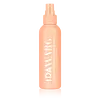What's inside
What's inside
 Key Ingredients
Key Ingredients

 Benefits
Benefits

 Concerns
Concerns

 Ingredients Side-by-side
Ingredients Side-by-side

Water
Skin ConditioningPentylene Glycol
Skin ConditioningCetearyl Alcohol
EmollientBehentrimonium Chloride
PreservativeLimnanthes Alba Seed Oil
Skin ConditioningDimethicone
EmollientCamellia Japonica Seed Oil
EmollientCetrimonium Chloride
AntimicrobialIsodecyl Neopentanoate
EmollientGluconolactone
Skin ConditioningSodium Benzoate
MaskingCalcium Benzoate
PreservativeSodium Hydroxide
BufferingIsopropyl Alcohol
SolventParfum
MaskingCitral
PerfumingLimonene
PerfumingLinalool
PerfumingWater, Pentylene Glycol, Cetearyl Alcohol, Behentrimonium Chloride, Limnanthes Alba Seed Oil, Dimethicone, Camellia Japonica Seed Oil, Cetrimonium Chloride, Isodecyl Neopentanoate, Gluconolactone, Sodium Benzoate, Calcium Benzoate, Sodium Hydroxide, Isopropyl Alcohol, Parfum, Citral, Limonene, Linalool
Water
Skin ConditioningCetearyl Alcohol
EmollientMethylpropanediol
SolventIsopropyl Myristate
EmollientAloe Barbadensis Leaf Extract
EmollientPanthenol
Skin ConditioningHydrolyzed Wheat Protein
Skin ConditioningGlycerin
HumectantMaltodextrin/Vp Copolymer
Citrus Aurantium Amara Peel Oil
Skin ConditioningCitrus Aurantium Bergamia Fruit Oil
MaskingTrideceth-6
EmulsifyingLactic Acid
BufferingLeuconostoc/Radish Root Ferment Filtrate
AntimicrobialPropoxytetramethyl Piperidinyl Dimethicone
Behenamidopropyl Dimethylamine
EmulsifyingBenzyl Salicylate
PerfumingEthylhexylglycerin
Skin ConditioningPhenoxyethanol
PreservativeParfum
MaskingLinalool
PerfumingLimonene
PerfumingGeraniol
PerfumingCoumarin
PerfumingHydroxycitronellal
PerfumingPinene
Masking3-Methyl-5-(2,2,3-Trimethyl-3-Cyclopentenyl)Pent-4-En-2-Ol
PerfumingCitrus Limon Peel Oil
MaskingTrans-Rose Ketone-3
PerfumingLinalyl Acetate
MaskingDimethyl Phenylethyl Carbinyl Acetate
PerfumingEugenia Caryophyllus Leaf Oil
MaskingTerpineol
MaskingBeta-Caryophyllene
MaskingTetramethyl Acetyloctahydronaphthalenes
MaskingGeranyl Acetate
PerfumingBenzaldehyde
MaskingAlpha-Terpinene
PerfumingTerpinolene
PerfumingVanillin
MaskingWater, Cetearyl Alcohol, Methylpropanediol, Isopropyl Myristate, Aloe Barbadensis Leaf Extract, Panthenol, Hydrolyzed Wheat Protein, Glycerin, Maltodextrin/Vp Copolymer, Citrus Aurantium Amara Peel Oil, Citrus Aurantium Bergamia Fruit Oil, Trideceth-6, Lactic Acid, Leuconostoc/Radish Root Ferment Filtrate, Propoxytetramethyl Piperidinyl Dimethicone, Behenamidopropyl Dimethylamine, Benzyl Salicylate, Ethylhexylglycerin, Phenoxyethanol, Parfum, Linalool, Limonene, Geraniol, Coumarin, Hydroxycitronellal, Pinene, 3-Methyl-5-(2,2,3-Trimethyl-3-Cyclopentenyl)Pent-4-En-2-Ol, Citrus Limon Peel Oil, Trans-Rose Ketone-3, Linalyl Acetate, Dimethyl Phenylethyl Carbinyl Acetate, Eugenia Caryophyllus Leaf Oil, Terpineol, Beta-Caryophyllene, Tetramethyl Acetyloctahydronaphthalenes, Geranyl Acetate, Benzaldehyde, Alpha-Terpinene, Terpinolene, Vanillin
 Reviews
Reviews

Ingredients Explained
These ingredients are found in both products.
Ingredients higher up in an ingredient list are typically present in a larger amount.
Cetearyl alcohol is a mixture of two fatty alcohols: cetyl alcohol and stearyl alcohol. It is mainly used as an emulsifier. Emulsifiers help prevent the separation of oils and products. Due to its composition, it can also be used to thicken a product or help create foam.
Cetearyl alcohol is an emollient. Emollients help soothe and hydrate the skin by trapping moisture.
Studies show Cetearyl alcohol is non-toxic and non-irritating. The FDA allows products labeled "alcohol-free" to have fatty alcohols.
This ingredient is usually derived from plant oils such as palm, vegetable, or coconut oils. There is debate on whether this ingredient will cause acne.
Due to the fatty acid base, this ingredient may not be Malassezia folliculitis safe.
Learn more about Cetearyl AlcoholLimonene is a fragrance that adds scent and taste to a formulation.
It's found in the peel oil of citrus fruits and other plants such as lavender and eucalyptus. The scent of limonene is generally described as "sweet citrus".
Limonene acts as an antioxidant, meaning it helps neutralize free radicals.
When exposed to air, oxidized limonene may sensitize the skin. Because of this, limonene is often avoided by people with sensitive skin.
The term 'fragrance' is not regulated in many countries. In many cases, it is up to the brand to define this term. For instance, many brands choose to label themselves as "fragrance-free" because they are not using synthetic fragrances. However, their products may still contain ingredients such as essential oils that are considered a fragrance.
Learn more about LimoneneLinalool is a fragrance and helps add scent to products. It's derived from common plants such as cinnamon, mint, citrus, and lavender.
Like Limonene, this ingredient oxidizes when exposed to air. Oxidized linalool can cause allergies and skin sensitivity.
This ingredient has a scent that is floral, spicy tropical, and citrus-like.
Learn more about LinaloolParfum is a catch-all term for an ingredient or more that is used to give a scent to products.
Also called "fragrance", this ingredient can be a blend of hundreds of chemicals or plant oils. This means every product with "fragrance" or "parfum" in the ingredients list is a different mixture.
For instance, Habanolide is a proprietary trade name for a specific aroma chemical. When used as a fragrance ingredient in cosmetics, most aroma chemicals fall under the broad labeling category of “FRAGRANCE” or “PARFUM” according to EU and US regulations.
The term 'parfum' or 'fragrance' is not regulated in many countries. In many cases, it is up to the brand to define this term.
For instance, many brands choose to label themselves as "fragrance-free" because they are not using synthetic fragrances. However, their products may still contain ingredients such as essential oils that are considered a fragrance by INCI standards.
One example is Calendula flower extract. Calendula is an essential oil that still imparts a scent or 'fragrance'.
Depending on the blend, the ingredients in the mixture can cause allergies and sensitivities on the skin. Some ingredients that are known EU allergens include linalool and citronellol.
Parfum can also be used to mask or cover an unpleasant scent.
The bottom line is: not all fragrances/parfum/ingredients are created equally. If you are worried about fragrances, we recommend taking a closer look at an ingredient. And of course, we always recommend speaking with a professional.
Learn more about ParfumWater. It's the most common cosmetic ingredient of all. You'll usually see it at the top of ingredient lists, meaning that it makes up the largest part of the product.
So why is it so popular? Water most often acts as a solvent - this means that it helps dissolve other ingredients into the formulation.
You'll also recognize water as that liquid we all need to stay alive. If you see this, drink a glass of water. Stay hydrated!
Learn more about Water